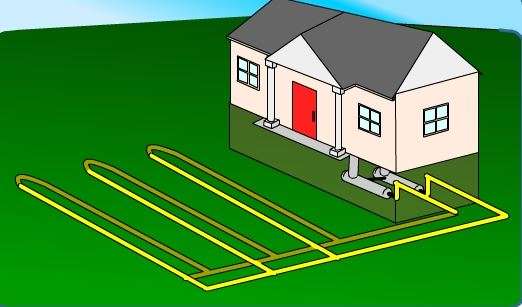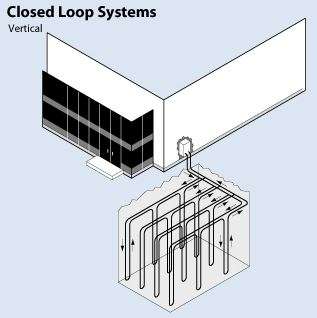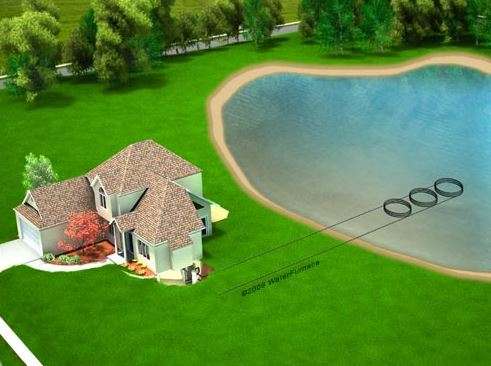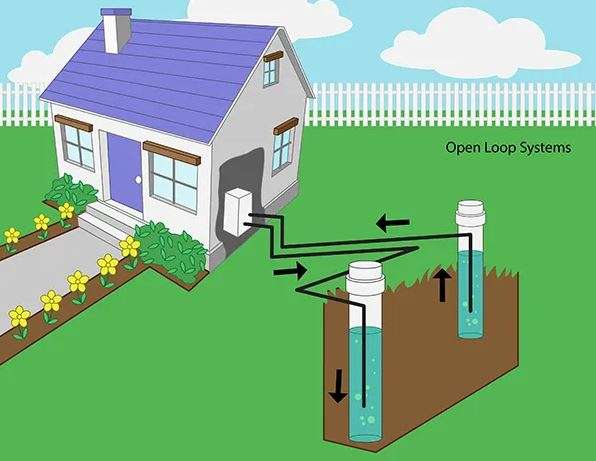In this article we will discuss Different Designs of Geothermal Heat Pump Systems. There are four major types of geothermal heat pump systems, each with its own distinct design. Three of these systems are categorised as “closed-loop systems,” while the fourth is classified as a “open-loop system.”
The sections that follow go over each of these numerous types of geothermal heat pump systems.
Closed-Loop Geothermal Heat Pump Systems
Three different designs that are employed around the world fall into the closed-loop category.
Table of Contents
Different Designs of Geothermal Heat Pump Systems
Closed-Loop Horizontal Systems
The closed-loop horizontal system is one of the most prevalent designs utilised in residential projects. It can be quite cost effective, especially when put in new construction areas with enough acreage.
The ground loop in this sort of heat pump system is frequently configured with additional loops/coils (as indicated in the diagram to the right) to minimise installation costs and conserve space.

Trenches of 1.5m or more must be dug in order to bury the loop at a depth sufficient to allow the heat pump to operate efficiently.
A horizontal closed-loop system can be installed in regions that do not have large amounts of vacant land, but it is still unsuited for more limited areas such as inner-city projects and corporate centres.
Closed-Loop Vertical Systems
The closed-loop vertical system is designed similarly to the closed-loop horizontal system, however instead of a horizontal loop system, the loop is inserted deep into the soil on the vertical axis.
Closed-loop vertical systems require substantially less land than horizontal systems and are thus more typically employed when space is limited or only a small piece of land must be disturbed during installation.

The vertical holes that house the loop system can range in depth from 30m to 120m. Because of the depth of these holes, specialised drilling equipment must be procured, raising the cost of this sort of heat pump system.
Vertical systems are more typically used in commercial buildings where horizontal loops are impractical.
Closed-Loop Pond/Lake Systems
Ground loop systems do not need to be buried to function properly.
By burying the loop into a supply of water, geothermal heat pump systems can be put in a pond or lake.
This supply of water should be 2.5m or deeper in order to offer efficiency and prevent the loop from freezing.

A closed-loop pond or lake system is similar in design to a closed-loop horizontal system, except the loop is lowered into a body of water rather than buried beneath the earth. This design is also considerably less frequent because it necessitates a huge pond or lake with suitable depth.
Open-Loop Geothermal Heat Pump Systems
To transmit thermodynamic energy, open loop geothermal systems employ groundwater as a refrigerant. Open loop geothermal systems are a great alternative for efficiency since water is an excellent thermal conductor and groundwater is naturally insulated and considerably closer in temperature to the surrounding ground. Open loop geothermal systems can be built to use water from a well as both a source and a sink, water from a pond or lake as both a source and a sink, or water from a well as both a source and a sink. Every installation is unique, and many elements of each system impact cost, space required, and system efficiency.
Due to its unique design that uses two wells of water, only one type of heat pump system falls within the open-loop category.
Open-Loop Well Systems
Water stored in a well is used as the heat exchange fluid in this arrangement, which runs directly via a ground source heat pump system.
After passing through a heat pump, the water is returned to the ground via a well, a recharge well, or even surface discharge.

Because one or more wells in the area of the building must be heated, this form of heat pump system is extremely uncommon. Furthermore, the water must be sufficiently clean in order to avoid system damage and give efficiency.